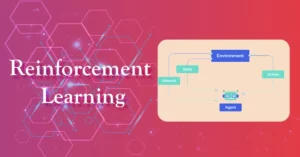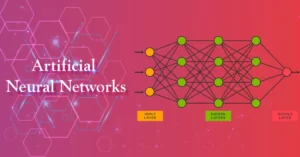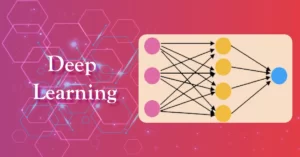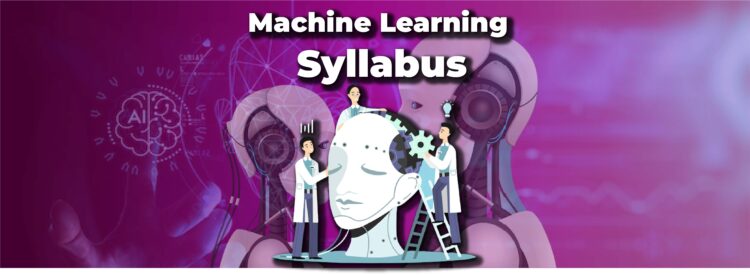Introduction to Machine Learning Syllabus
We will learn about Machine Learning Syllabus in this article. Machine Learning is a field of Artificial Intelligence that enables computers to automatically learn and improve from their experiences. It is described as the branch of science that permits machines to understand without even being explicitly programmed. It’s not the same as typical programming. All businesses rely on data to function. Data-driven choices are increasingly determining whether a company stays competitive or falls further behind.
Machine learning syllabus has the potential to uncover the value of the business and consumer data and enable companies to make decisions that keep them ahead of the competition.
Data from Glassdoor indicates that the percentage of machine learning job postings has been steadily increasing between 2016 and 2021. Already, in 2022, there is a 70% increase over 2021, although the year has only barely begun. Students are opting for and enrolling themselves in data science courses so they can keep up with the trend. However, It is become increasingly difficult to learn or even search for a course if you don’t know what should be in the machine learning syllabus.
Therefore, I will be sharing the knowledge of machine learning and machine learning syllabus in this article. Let’s get started.
What is Machine Learning?

Machine learning is a branch of computer science that enables computers to learn without even being explicitly programmed. One of the most intriguing technologies that one has ever encountered in machine learning. As the name suggests, it offers the computer the ability to learn, which makes it more human-like. Machine learning syllabus is now in use, maybe in many more locations than one might imagine.
Computer systems can use all of the client data thanks to machine learning. It follows the program’s instructions while also adapting to new circumstances or changes. Algorithms adapt to input and produce behaviors that aren’t pre-programmed.
A digital assistant might scan email and extract the relevant information if it learned to read and identify the context. The capacity to create predictions about future client behavior is inherent in this learning. This allows you to have a better understanding of your clients and be proactive rather than reactive.
Machine learning is significant because it allows businesses to see trends in customer behavior and company operating patterns while also assisting in the creation of new goods. Machine learning is at the heart of many of today’s most successful businesses, like Facebook, Google, and Uber. For many businesses, machine learning became a crucial competitive differentiation.
Machine learning syllabus may be divided into 3 categories on a broader level:
- Supervised learning
- Unsupervised learning
- Reinforcement learning
Important Subject in Machine Learning Syllabus

Supervised Learning

In this machine learning syllabus article, a supervised machine learning approach that, like the student-teacher interaction, requires supervision. A system is taught with well-labeled data in supervised learning, which implies some data has already been tagged with proper outputs. As a result, anytime new data is input into the machine, supervised algorithms examine it and use the labeled data to anticipate proper outputs.
In machine learning syllabus it is divided into two types of algorithms. The following are some examples:
- Classification: When the result comes in the form of a category, like yellow, green, right or wrong, etc., classification is used.
- Regression: When the main outputs are real values such as age, height, and so on, regression is used.
Unsupervised Learning

In this machine learning syllabus article the unsupervised method does not require categorization, unlike supervised learning. Even with no labeled training data, it seeks to categorize unsorted data based on certain patterns and differences. Because there is no supervision in unsupervised learning, no sample data is provided to the computers. As a result, robots can only find hidden patterns in unlabeled data on their own.
Reinforcement Learning

In this machine learning syllabus article, Reinforcement learning is a machine learning approach based on feedback it does not require labeled data. A machine learns to function in a given environment by executing actions and witnessing the outcomes of those actions. Positive feedback for good activities and negative feedback for poor ones are available from agents. Because there is no training data in reinforcement learning, machines can only learn from their own experiences.
Artificial Neural Networks

In this machine learning syllabus article, Artificial Neural Networks (ANNs) and simulated neural networks (SNNs) are types of neural networks that are used in deep learning techniques. Their name and architecture are inspired by the human brain, and they function similarly to biological neurons. Artificial Neural Networks (ANNs) are a form of learning algorithm artificial neural. That is, much like neurons in our central nervous can learn from previous data, the ANN may learn from data and respond in the manner of forecasts.
Nonlinear statistical models, or ANNs, demonstrate a complicated relationship between inputs and outputs in order to uncover a new pattern in machine learning syllabus. Artificial neural networks are used for a range of applications including image identification, speech recognition, machine translation, and medical diagnosis
Deep Learning

In this machine learning syllabus article Deep Learning is a machine learning approach that allows computers to learn by example in the same way that people do. Deep learning is a critical component of self-driving automobiles, allowing them to detect a stop sign or discriminate between a pedestrian and a lamppost.
It enables voice commands in consumer electronics such as phones, tablets, televisions, and hands-free speakers. Deep learning has gotten a lot of press recently, and for good cause. It’s accomplishing accomplishments that were previously unattainable. Therefore, it’s an important p
art of the Artificial Intelligence.
Conclusion
In this machine learning syllabus article we have covered everything from scratch to the advanced levels. From supervised learning, unsupervised learning, reinforcement learning, artificial neural networks, deep learning, etc.
This machine learning syllabus article is for beginners to understand machine learning click here to know more about data science artificial intelligence.
Frequently Asked Questions
What should I study for machine learning?
Machine Learning is without a doubt the most sought-after technology of our day! If you’re a beginner just beginning to work with Machine Learning, it’s critical that you understand the requirements. ‘Machine Learning Syllabus’ article will assist you in grasping the many ideas necessary to begin working with Machine Learning. Let’s have a look at what should you study for the machine learning syllabus:
- Statistics: Statistics include techniques that could be utilized to get a result from data. There are descriptive statistics that are used to turn raw data into useful information. Inferential statistics may also be used to extract crucial data from a sample of data rather than the entire dataset.
- Linear Algebra: Vectors, matrices, and linear transformations are all dealt with in linear algebra. It is crucial in machine learning since it can be used to change and manipulate datasets.
- Calculus: Calculus is an essential branch of mathematics that is used in a variety of machine learning methods.
- Probability: Probability assists us in predicting the possibility of events and in reasoning whether or not the circumstance will occur again. Probability is a cornerstone for machine learning.
- Programming Languages: To implement the entire Machine Learning process, computer languages such as R and Python are required. Both Python and R include built-in libraries that make implementing Machine Learning algorithms a breeze.
These are some of the essential components of machine learning syllabus.
AI/Machine Learning will likely be a popular issue in computer science for years to come. Interestingly, they have also been a hot issue for a long time. That is simply because AI and machine learning bring a lot to the table and will continue to do so. People frequently believe AI and machine learning are interchangeable or have comparable functions. Each of them, though, has a distinct job to play and you should must be aware about machine learning syllabus.
We may infer that AI has a broader scope than ML based on all of the factors used to define the distinction between AI and ML. AI is a discipline of science that has a built-in intelligence system. Yet, we cannot argue that AI is meaningless without machine learning.
Is learning machine learning hard?
R and Python, which are both free and easy to install on your own computer, support a wide range of unsupervised and supervised models, and even simple models like logistic or regression models may be used to conduct fascinating and significant machine learning. Although many sophisticated machine learning tools are difficult to use and require an extensive understanding of advanced math, stats, and computer engineering, novices may get a lot done with the fundamentals, which are freely available.
Some math is required to grasp machine learning. Machine learning is built on the foundations of linear algebra, statistics, and probability. It’s time to brush up on your high school arithmetic if you’re serious about joining the machine learning bandwagon. Data analysis, in addition to arithmetic, is a necessary ability for machine learning.
Machine learning is built on the capacity to crunch data in order to draw relevant insights and patterns. The important phases in data analysis include loading a big data set, cleaning it to fill in missing data, and slicing and dicing the data set to uncover patterns and relationships. For more information read our blog on the machine learning syllabus.
Can a fresher get a job in machine learning?
Obviously. If a fresher acquires the needed abilities, he or she can secure a machine learning job. Freshers have to plan how they would perform effectively and work well with professionals who have significant expertise in the same subject to have a solid career in the artificial learning environment.
Can I learn ML without data science?
The main essential ability for machine learning is data analysis for novices, and it is not necessary to master calculus or linear algebra to design a model that generates correct predictions.
Data science, more than any other academic degree, is about learning and taking up things quickly and precisely. You can take up intuitions and strategies quickly and accurately with rigorous math, and you may have a quicker learning curve than others also cover your machine learning syllabus.
To work as a Machine Learning Engineer, you’ll need a few prerequisites. Overall, this job includes reviewing and organizing data, running tests, and ultimately monitoring and optimizing the learning process in order to produce high-performing machine learning systems.
As a Machine Learning Engineer, you’ll be responsible for applying algorithms to various codebases, therefore software engineering expertise is ideal for this role. Essentially, the right mix of math, stats, and web development will provide you with the necessary foundation — once you understand these ideas, you’ll be ready to apply for Machine Learning jobs.
Even if you lack that background, you may pursue a job in machine learning. To begin, you’ll need to learn about basic machine learning methodologies as well as the tools needed to create, operate, and optimize machine learning algorithms. Many people choose to enroll in a data science boot camp or a machine learning school to accelerate their learning and prepare for a career as a Machine Learning Engineer.
In six easy steps, you can become a Machine Learning Engineer.
- Learn Python
- Take a machine learning class.
- Make your own machine learning project.
- Learn how to collect the proper information.
- Participate in a contest or join an online machine learning community.
- Apply for internships and jobs in machine learning.
Let’s move on to the next FAQ of Machine Learning Syllabus.
Is machine learning a good career?
Machine learning is a subfield of AI that relies on data & algorithms to allow computers to learn given tasks with little or no human interaction. Yes, if you’re interested in technology, robotics, and algorithms, machine learning then this machine learning syllabus is indeed a fantastic for you. Your day will be spent evaluating enormous quantities of data and applying and automating it.
If money is essential to you, a job in machine learning might provide an excellent starting wage. “AI, Machine Learning, and Robotics will enable the development of 97 million new employment by 2025,” as per the World Economic Forum. As a result, we believe that now is an excellent moment to begin a profession in machine learning. Let’s move on to the next FAQ of Machine Learning Syllabus.
Can a fresher get a job in machine learning?
Obviously. If a fresher acquires the needed abilities, he or she can secure a machine learning job. Freshers have to plan how they would perform effectively and work well with professionals who have significant expertise in the same subject to have a solid career in the artificial learning environment.
There’s no denying that improving machine learning algorithms by research is a challenging science. It necessitates imagination, experimentation, and perseverance all you need to know about machine learning syllabus. Implementing old models and methods to work successfully for any application remains a difficult task.
There’s no denying that improving machine learning techniques through research is a challenging science. It necessitates imagination, experimentation, and perseverance. Implementing old models and methods to work successfully for your application remains a difficult task.
Which language is best for machine learning?
Python is the most popular programming language among data scientists and machine learning developers, with 57% using it and 33% prioritizing this for development. It’s no surprise, considering the rapid growth of the deep learning Python framework in the last two years, which has seen the introduction of TensorFlow and a slew of additional libraries.













